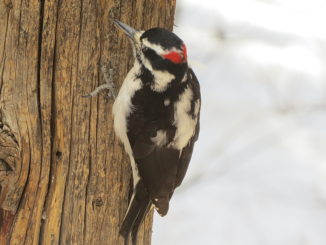Cindy Henk has a long-term love affair with science education. She’s especially enamored of microscopes and sharing the wonders of the world they reveal. For 30 years she managed a biology lab at Louisiana State University, and it was there that she first learned about a very special microscope — one capable of displaying its secrets on a screen so that every student in a classroom can see, and their teachers can point out and discuss the object under observation.
 [/media-credit]
[/media-credit]
Dubbed “scope on a rope” because the original model sprouted a series of cables to make connections with a TV or projector, a newer digital model lost the cables but kept the name. Handheld and only a few inches long, the scope attaches to most smart phones and produces an instant image of what the microscope sees. The scope utilizes airMicro, an 99-cent iPhone app that converts any iPod Touch or iPhone into a receiver for the microscope.
Once costing upwards of $13,000, the scope now costs only a few hundred dollars. And most science teachers can have it up and running in less than five minutes.
Henk and her husband, Bill, also a biologist, retired a few years ago and moved into an off-the-grid, solar-dependent, passive thermal home they designed at Phantom Canyon Ranches in the foothills northwest of Fort Collins. Bill likes to stay nestled in his mountain retreat most of the time, but Cindy needs to feed her passion. She has volunteered at the Discovery Science Center in Fort Collins and at the Livermore and Red Feather Lakes elementary schools.
This summer she will teach one-day workshops at Soaring Eagle Ecology Center, a non-profit science education center founded by Judy and Tom Viola on 10 acres of land adjacent to the Red Feather school. Henk will conduct a wildflower identification workshop and a wetlands workshop. Both will make use of the “scope on a rope” to identify plants, algae, and bacteria found in the water at the center. (Workshops are limited to 18 participants. Anyone interested can find detailed information and a registration form at: www.seecatrfl.org)
Henk has been an advocate for the “scope on a rope” since the day she learned of its existence. She has travelled to Japan to visit the manufacturer, and has written grants to help make this invaluable tool accessible to science teachers across the country. She explains that while everyone who has an opportunity to use the scope falls in love with it, a major marketing effort must be mounted if it is to become an accepted necessity in the science classroom. “It all boils down to dollars,” she says.
Meanwhile Henk gives of her time and shares her scope whenever she has the opportunity. It is the way she indulges her love, not only of science, but of finding ways in which its wonders can be made accessible and exciting to students. “Kids are blown away by what they see through the scope,” she says. “It opens up whole new worlds to them.”
Support Northern Colorado Journalism
Show your support for North Forty News by helping us produce more content. It's a kind and simple gesture that will help us continue to bring more content to you.
BONUS - Donors get a link in their receipt to sign up for our once-per-week instant text messaging alert. Get your e-copy of North Forty News the moment it is released!
Click to Donate


